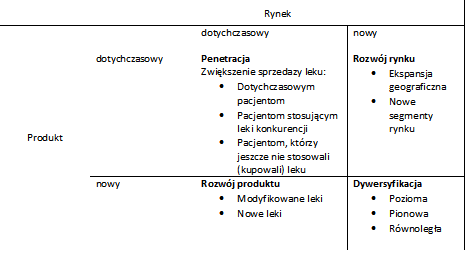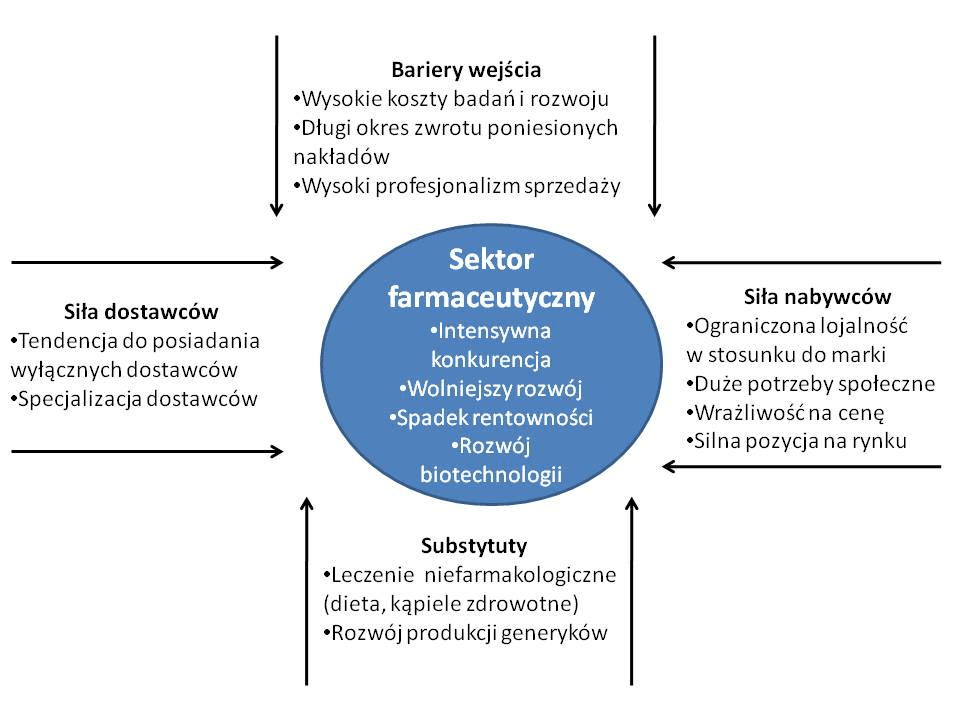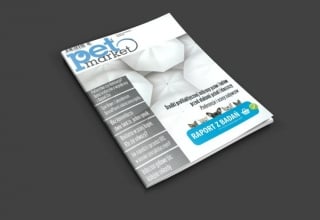Aby zapewnić rozwój przedsiębiorstw, działających na rynku farmaceutycznym, stale wytyczane są nowe cele i określa się sposoby ich osiągania. Taki sposób myślenia i działania w odniesieniu do marketingu i jego związku z rozwojem przedsiębiorstwa jest traktowany jako marketing strategiczny.
Proces budowy strategii, które zdynamizują rozwój firmy na rynku, spędza sen z powiek farmamarketerów. Jedno z zaleceń mówi o tworzeniu własnego, w miarę niepowtarzalnego rynku. Wybór rynku leków OTC, Rx, suplementów diety lub pewnej ich kombinacji w dużej mierze decyduje o sposobach działania firmy. Sposoby te mogą być uwarunkowane historią firmy (wcześniejsze odkrycia, patenty, systemy terapeutyczne) lub wynikać z przyjętej orientacji (np. podjęcie produkcji leków generycznych). W celu poszerzenia możliwości działania, duże koncerny przejmują mniejsze podmioty, zapewniając sobie dostęp do nowych rynków, knopw-how, innowacyjnych cząsteczek, patentów, technologii produkcyjnych. Na rodzimym rynku można tu wymienić chociażby akwizycje Polpharmy i Adamedu.
Strategie marketingowe realizowane przez przedsiębiorstwa działające na rynku farmaceutycznym mieszczą się najczyściej w jednym z klasycznych podziałów strategii lub stanowią kombinacje różnych strategii. Można wskazać dwa klasyczne podziały:
– strategia kształtowania pola rynkowego
– strategie konkurencji.
Strategia kształtowania pola rynkowego opiera się na dwu zmiennych: produkcie i rynku.
W analizie relacji między tymi dwoma czynnikami wykorzystuje się macierz Ansoffa, która umożliwia wyodrębnienie czterech grup strategii. Strategie produktowo-rynkowe związane są z wyborem rynku docelowego i pozycjonowaniem produktu. Pozycja produktu wyznacza z kolei zastosowanie poszczególnych instrumentów marketing-mixu i określa stopień intensywności jego wykorzystania. Co istotne, ta strategia łączy dwa istotne elementy rynku – konkurentów i pacjentów.
Rys.1. Strategia kształtowania pola rynkowego
 Strategię penetracji rynku (zwiększenia sprzedaży tych samych leków w tym samym segmencie rynku) stosują producenci, którzy dążą do zmiany kategorii leków Rx na OTC.
Strategię penetracji rynku (zwiększenia sprzedaży tych samych leków w tym samym segmencie rynku) stosują producenci, którzy dążą do zmiany kategorii leków Rx na OTC.
Ta strategia realizowana jest także przez te firmy, których leki zostały dopuszczone do sprzedaży pozaaptecznej, w sklepach i na stacjach benzynowych. Leki stają się powszechnie dostępne i przez to częściej kupowane.
Na polskim rynku farmaceutycznym wykorzystywane są w zasadzie wszystkie strategie rozwoju rynku:
- eksport bezpośredni i pośredni na polski rynek (Eli Lilly, Merck)
- tworzenie oddziałów w Polsce i budowa zakładów produkcyjnych (KRKA)
- fuzje, przejecie (GSK wykupił Polfę Poznań, Sanofi-Aventis Zentivę i Nepentes, sprzedaż poszczególnych Polf przez Polskie Holding Farmaceutyczny).
Strategią różną od rozwoju przestrzennego jest strategia rozwoju rynku przez dotarcie do innych segmentów rynku, czyli modyfikacja produktu pod kątem potrzeb różnych segmentów (Aflofarm: Valerin sen, soft, forte, max).
Strategia rozwoju produktu (na dotychczasowym rynku) może przyjąć następujące formy:
podwyższenie poziomu jakości leku przy zachowaniu jego dotychczasowych własności
nadawanie lekom nowych właściwości przez stosowanie różnych dodatków, zwiększenie ilości substancji czynnej (active, max, forte, noc, dzień itp.)
ułatwienia w użytkowaniu leku: oferowanie go w różnych postaciach i formach (tabletki, plastry, krople, zawiesina, czopki, ampułki itd.), a także w „inteligentnych” opakowaniach (tabletki antykoncepcyjne z kalendarzem ułatwiającym przyjmowanie leku)
poprawę estetyki leku poprzez zmianę identyfikacji wizualnej.
Modyfikacja leków jest reakcją na zmiany warunków rynkowych. Główną przesłanka takiego działania są zmiany preferencji nabywców i pojawienie się produktów konkurencyjnych, które mogą lepiej spełniać oczekiwania pacjentów. Strategia modyfikacji produktu opiera się przede wszystkim na budowaniu przewagi konkurencyjnej i unikaniu (poprzez zróżnicowanie leku) konfrontacji z konkurentami.
Strategia oparta na wprowadzaniu na rynek nowych leków niesie za sobą duże ryzyko, gdyż jest to długotrwały proces i wysokie ryzyko występuję na każdym z jego etapów. Ciekawym przykład to działania firm innowacyjnych, które po wygaśnięciu patentu czasem same wprowadzają lek odtwórczy. Dokonują tego poprzez zależnych od nich producentów leków generycznych lub alianse z innymi firmami (Sandoz – Novartis, Pfizer- Schwartz Pharma).
Strategie dywersyfikacji polegają na poszukiwaniu możliwości rozwoju przedsiębiorstwa przez wprowadzenie na rynek nowych preparatów. Następuje ona dzięki własnym zasobom przedsiębiorstwa, przez fuzji z innymi podmiotami lub ich nabycie
Warto wspomnieć o realizacji strategii dywersyfikacji pionowej na rynku farmaceutycznym. Ma ona miejsce głównie w sferze handlowej (integracja hurtu farmaceutycznego z detalem – apteki).
Obok strategii produktowo – rynkowych, występują strategie konkurencji w postaci:
- niskich kosztów (niskich cen)
- zróżnicowania (wysokiej jakości)
- koncentracji na wybranym segmencie rynku.
Przesłanką do wyboru którejś z ww. jest analiza sił rządzących konkurencją.
Rys. 2. Główne siły rządzące konkurencją w sektorze farmaceutycznym
Strategie marketingowe
Podstawowe rodzaje konkurencji i typy przewago konkurencyjnej:
konkurencja i przewaga cenowa – cena oraz instrumenty promocji mają zainteresować nabywcę materialnymi korzyściami z nabycia danego produktu (większe opakowanie leku za tę sama cenę).
Konkurencja i przewaga jakościowa – nacisk na elementy marketing mix, głównie produkt, dystrybucja, ale także personel (lekarz, przedstawiciel medyczny, farmaceuta).
Konkurencja i przewaga informacyjna – wykorzystuje się siłę marki, stawiając przy tym na reklamę, PR, narzędzia promocji sprzedaży. Odniesienie do pozamaterialnych aspektów zainteresowania nabywców (skuteczność, bezpieczeństwo przyjmowania leku).
Rynek farmaceutyczny należy do rynków o wyjątkowo intensywnych procesach konkurencji. Dany producent może posiadać w swoim portfolio leki oryginalne i generyczne, konkurujące ze sobą. Duża liczba wyspecjalizowanych podmiotów pośredniczących powoduje nakładanie się obszarów działania (hurtownie, apteki). Wybór strategii konkurowania jest po prostu trudną decyzją.
Strategia dominującej pozycji pod względem niskich kosztów nie jest tożsama ze strategią niskich cen. Jest ona oparta na skuteczności i efekcie doświadczenia związanym najczęściej z dużym udziałem firmy w rynku. Sanofi –Aventis, producent No-Spa, zdobywszy wysoki udział dla tego leku w swoim segmencie, może stosować strategię niskich kosztów, celem wyróżnienia tego produktu pod kątem ceny.
Firma stosująca strategię różnicowania stawia na leki wysokiej jakości, osiąga dużą efektywność działań marketingowych, utrzymuje dobry wizerunek firmy (marki). Ta strategia ma duże szanse powodzenia w pewnych warunkach:
- potrzeby pacjentów są zróżnicowane i nie mogą być zaspokojone przez lek o standardowym składzie lub formie
- istnieje wiele możliwości różnicowania leku, a nowe formy są dostrzegane i akceptowane przez pacjentów
- efekt zróżnicowania nie może być łatwo i szybko skopiowany przez konkurentów
- koszt zróżnicowania leku jest wysoki, ale klienci akceptują wyższą cenę produktu.
Strategia koncentracji to skupienie się przedsiębiorstwa na wybranym segmencie rynku. Wiąże się to ze specjalizacją produktową i obsługa wybranego segmentu rynku, wyróżnionego najczęściej z uwagi na charakter jednostki chorobowej lub cechy demograficzne (niemowlęta, kobiety itp.). Przykładowo, firmy homeopatyczne przez długi czas skoncentrowane były na segmencie pediatrycznym.
Firmy farmaceutyczne stosują najczęściej strategie mieszane. Nasilające się zjawiska konkurencji i nowe zachowania nabywców są zasadniczym wyróżnikiem tych zmian.
Na jaką strategię postawi Twoja firma?
Osoby zainteresowane zgłębieniem problematyki artykułu odsyłam do książki H. Mruka,
B. Pilarczyk, M. Michalik Marketing strategiczny na rynku farmaceutycznym, wyd. Wolters Kluwer Polska. Przygotowując artykuł, wsparłem się treściami z 12 rozdziału książki.
Jest to gościnny wpis Seweryna Maj, pasjonata nowoczesnych technologii, farmamarketera pracującego w firmie farmaceutycznej Heel Polska Sp. z o.o.









